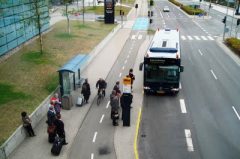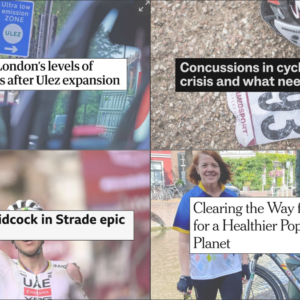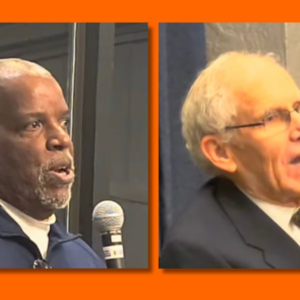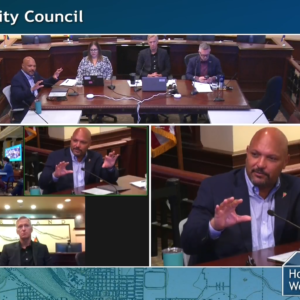
Beginning with a welcome reception at a downtown brewery tomorrow, Metro will host a European delegation as part of their Transatlantic Active Transportation Workshop. The four-day event is just the latest example of bicycle-related knowledge sharing between experts from America and Europe.
Portland has been sending city planners and engineers to cities like Copenhagen and Amsterdam since at least 2005 (when I first mentioned it here on BikePortland). Since then, there have been several other trips with similar goals.
And Portland politicians, bureaucrats, and planners aren’t the only ones who have realized the value of studying cities where bicycling is actually a viable option to the car for a majority of residents.
Back in May, an unlikely trio of sponsors — the Federal Highway Administration (FHWA), the American Association of State Highway Transportation Officials (AASHTO), and the National Cooperate Highway Research Program (considered the evil “highway lobby” by many) — paid for a study trip to five countries in Europe. In the delegation were staffers from those agencies, along with planners, advocates and researchers. The goal was to scan what leading European cities were doing to encourage and facilitate biking and walking. Their findings and recommendations from a preliminary report were nothing less than a revelation. They recommended implementation of separated facilities (like cycle tracks), bike-specific traffic signals, aggressive encouragement programs, and so on. (City of Portland’s bike coordinator Roger Geller called it “very encouraging”. Download a draft summary report of that trip here – 1.5mb PDF)
This past August, national non-profit Bikes Belong launched their Bicycling Design Best Practices Project and hired a Harvard urban planning grad to oversee it. The goal, according to Bikes Belong, is to take as many Americans to Europe as possible, with the intent to, “improve U.S. bicycling infrastructure by encouraging the implementation of innovative, successful models of bike facility design, engineering and promotion — many of them developed in northern Europe.”
But the U.S./European bike knowledge sharing trend is far from one-way street.
After a PBOT staffer connected with two bike planners from Utrecht during this year’s Velo-City Conference in Brussels, he invited them to be special guests at the recent Safe Routes to School National Conference in Portland.
In late October, organizers of the Oregon Manifest event will host “An Evening Honoring the Danish Embassy,” with Copenhagen’s bike blogger and ambassador Mikael Colville-Andersen and Mayor Sam Adams.
Metro’s workshop which starts tomorrow evening and runs through this Friday, will host five delegates for a full schedule of discussions, luncheons, and hands-on tours. The focus of the workshop is to glean perspectives and expertise on active transportation projects, and learn from the delegates about how to create a region with cities where bicycles make up 30% of all trips taken.
Focus areas for the workshop include Lake Oswego, Clackamas, Beaverton, and Portland. The delegation will also be in attendance at Wednesday night’s David Byrne event at the Bagdad Theater.
-
Metro’s Transatlantic Active Transportation Workshop
Sept. 30 through Oct. 2
Full schedule at OregonMetro.gov






Thanks for reading.
BikePortland has served this community with independent community journalism since 2005. We rely on subscriptions from readers like you to survive. Your financial support is vital in keeping this valuable resource alive and well.
Please subscribe today to strengthen and expand our work.
If the bike path pictured above is an example of the infrastructure we can expect, I’m not for it.
What a mess! How can a cyclist doing 15-20 mph while commuting to work be expected to negotiate all those pedestrians? Why not put the bus stop in the center lane of the road and let the pedestrians dodge cars to get on the bus? Same difference.
High-speed cycling infrastructure for transportation, not recreation, if you please.
Ped’s are supposed to wait for cyclists to pass; either on the sidewalk or on the island, makes sense to me. Better than playing leap frog with the buses.
The picture above show people standing in the cycle track. Looks dangerous to me.
Anyway glad everybody is collaborating. Perhaps it will prevent bad design decisions like the one shown above.
Cyc, I have been a bike commuter most of my life currently I commute about 16 miles a day. I rarely reach speeds over 12MPH. If any city wants more people on bikes they can not just focus on the riders that want to travel 15-20MPH we also need to focus on people hauling kids and gear, older people and younger people. That looks quite functional to me.
More options that can get people to the same place while providing for different travel styles makes a lot of sense.
The people who are in and crossing the cycletrack will most likely be gone once the bus leaves. It is hard to believe that any one who has control of their bicycle should feel that this is a dangerous situation.
I too am glad to see that there is an exchange of ideas between countries but I will tell you that what works in Europe and what works here in America can’t always work if transplanted to the other continent.
I think the photo chosen is a perfect example. Yes this can work well in Europe where commuting speeds tend to be slower but wouldn’t be recommended here in the US. The first time a passenger walked off a bus and into a speeding cyclist all the lawyers would come out a put a stop to this.
Plus the bike path looks like its bi-directional! Talk about problems.
I was just in Germany again this Summer but the first time after completing my Urban Planning Masters focusing on bicycle and pedestrian facilities and I would easily say that about 10% to 20% of the bicycle facilities I saw over there made me cringe (door-zone bike lanes, narrow bike lanes next to narrow sidewalks, etc.). However the other 80% of the bicycle facilities blew me away! Trust me Europe is not perfect but they do have a head start in many ways.
Also there are cultural and legal differences in Europe. A bicycle route that goes straight into a quite pedestrian zone for resort tourists in my moms hometown would never fly here in America. There is just a little more gentility in Europe and the bike riders no matter what their strips know not to speed through this area. I doubt (unfortunately) that most Americans have the maturity to understand these unwritten courtesies that make such a facility work in Europe.
This is exactly the reason for such an exchange. People will talk and ideas will be transferred but not all ideas will have application in the other countries but you don’t know unless you listen to one another.
Just read about the problem in your Riverview Cemetery and of cyclists going too fast through it, resulting in the need for speed bumps. That’s an other perfect case of how things are different in Europe vs. here in the US.
Very few Europeans would think it proper to speed through a cemetery on a bike so the need to install speed bumps just would NOT be necessary there. In fact speed bumps are rarely ever used in Germany from what I’ve seen since other more sophisticated traffic calming measure and VERY strict traffic enforcement make drivers (and cyclists) very mindful of the consequences of violating the law.
@1
the cyclists using these infrastructure are never going as fast as you presumed. I’d say the average speeds in Copenhagen, Amsterdam and the like are more
like 6-10mph. BTW, the pictured system is ALL about transportation not recreation.
I guess the inverse of your question could
also be asked: how can cyclists expect a functional system to integrate all modes when one group insists on travelling at excessive speeds ?
I think your point is perfectly timed since we have recently begun the public discussion about reducing cyclist’s speed.
“…aggressive encouragement programs…”
“Ride your bike or PBOT will kick you in the shins.” That should work?
JayS #4 –
Here is an entire paragraph outlining the ways in which you would service only a particular, singular, riding style. Yours.
Then you turn right around and spew the party-line for good measure. So which is it? Do you support restrictive measures levied against other riding styles, or do want to compromise and change your riding style? You yourself say they are mutually exclusive.
How do you enforce speed on a human-powered-vehicle? The only way this will be effective is to mandate that cyclists install speed-measuring devices on their bicycles. So, now the omnipresent threat to my personal liberty by the Nanny State on yet another front? It’s not bad enough that I must add weight to my personal property, a direct contravention of it’s intended design, by installing lighting, I must now add an expensive speed-measuring device? Adding weight to my bike slows me down. I thought just a second ago you were advocating for all riding styles?
What about people who can’t even afford to comply with this invasive intrusion into their personal business in the first place? I’m riding sans rear light, or reflector either one right now, because I cannot afford to replace the light that is chronically, and repeatedly, stolen off my bicycle. Are you comfortable with suggesting that poor people be further burdened by these superfluous, Nanny State regulations?
The fact that you all need a bunch of paint, and exclusive access, and are willing to ban me from Oregon highways to get it, is driving a wedge into this bicycle community that will never come out. It’s painfully obvious to me as a mere observer that you are insecure about your paltry riding skills, and style. This insecurity manifests in you calling for me to change my behavior so that you do not look the helpless, mamma’s boy, fool, that you already look to be.
You may scoff as I blow by you on your 40 lb. two-wheel tank, but you may not legislate your disdain, whether it’s because you are an insecure weeny, or because you would save the planet from me.
Stop banning cyclists from Oregon highways, whether that’s how they do it in your precious Europe or not.
It’ll be very interesting to see how much of this transatlantic cross-pollination will actually come to anything. The most telling moment of the brown-bag discussion held at Metro last month came in response to the question about how they manage pedestrian-cyclist conflict in Utrecht, and the response was “there aren’t any.” Portland cycling will have to undergo a through transformation for many of the ideas & infrastructure developed in Europe for Europeans to work here, and it’s not at all clear to me that very many of Portland’s current cyclists want it to transform.
Personally, I think cycling is getting fairly close to the maximum mode share we can handle without such a transformation. As one of the presenters at the Brown Bag said, in his view it isn’t safe for the elderly or for children to be cycling in bike-congested spots like the Hawthorne Bridge at commute times. That’s because of the speed cyclists travel at. I think he’s right, and I might add, it isn’t even necessarily safe to walk in these areas anymore, thanks to aggressive cyclists. Either this changes, or cycling in Portland peaks out pretty soon.
“Here is an entire paragraph outlining the ways in which you would service only a particular, singular, riding style. Yours.” I beg to differ about your interpretation of my statement. Please read this sentence that you quoted again and notice the words that now appear in capitals, “If any city wants more people on bikes they can NOT JUST focus on the riders that want to travel 15-20MPH we ALSO need to focus on people hauling kids and gear, older people and younger people.” you will notice I say “… not just…” and “… also…” words which would imply other options.
“Do you support restrictive measures levied against other riding styles, or do want to compromise and change your riding style? You yourself say they are mutually exclusive.”
I do not support any restrictive measures against any riding style, nor do I see any place that I say that. For further clarification see my comments about your misinterpretation in the previous paragraph. Where do I say anything is mutually exclusive?
“It’s painfully obvious to me as a mere observer that you are insecure about your paltry riding skills, and style. This insecurity manifests in you calling for me to change my behavior so that you do not look the helpless, mamma’s boy, fool, that you already look to be.” THanks for making assumptions about me based on your misreading what I wrote (not observations of me as you state ). No where in my statement do I imply that I can’t or don’t claim my space on the road, I just ride slower than you when I have my kids. If a car needs to slow down while I am in the left lane of traffic making a left turn that is what they do.
Where in my statement do I say you have to use that piece of infrastructure? As I understand it according to oregon law if you see a bike lane (infrastructure) as unsafe you can ride in the lane of traffic. If you ride at a higher rate of speed than those in the cycle track don’t enter it, use the road. I’ll say the same basic thing again, No restrictions for people who ride fast or slow just more options for more people. When THEY come to say that bikes can’t ride in the street I’ll be there with you complaining, writing letters and fighting for good options for everyone.
Vance, we had this discussion in the spring, will we have to have a third round, or do you get it yet that I believe in options?
Bike Portland: Metro Transatlantic Workshop latest in U.S./European bike-cultural exchange:
Cycl.. http://bit.ly/2Nlyul